Hacksaw Ridge (2016): Directed By Mel Gibson / Country: USA/Australia / Starring: Andrew Garfield, Hugo Weaving, Teresa Palmer, Vince Vaughn, Sam Worthington.
Hacksaw Ridge has best-looking war scenes since Saving Privat Ryan and it has an incredible story based on true events. The movie only received two Academy Awards: Best Sound Mixing and Best Film Editing.
The Movie shows life of Desmon T. Doss (played by Andrew Garfield ), a skinny shipyard worker, vegetarian and devout Seventh-day Adventist who voluntarily enlisted himself in the army but refused to carry any weapon or work on Saturdays. He was awarded the Medal of Honour by President Harry Truman, the citation credited him with saving the lives of 75 men. Thus, Doss became the first non-combatant in US military history to receive such a commendation and one of only three since.
Not only that, he also lived a humble life and refused people that wanted to make a movie/book/etc. The reason he declined is that none of them adhered to his one requirement: that it needed to be accurate.
Early life
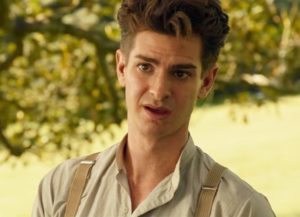
Desmond Doss was born in Lynchburg, Virginia, to William Thomas Doss (Hugo Weaving), a carpenter, and Bertha Edward Doss, a homemaker and shoe factory worker. He grew up in the Fairview Heights area of Lynchburg, Virginia alongside his older sister Audrey and younger brother Harold. Doss attended the Park Avenue Seventh-day Adventist Church school until the eighth grade and subsequently found a job at the Lynchburg Lumber Company to support his family during the Great Depression. The Great Depression left their father, a World War I veteran, depressed and turning to alcohol at times (though the movie exaggerates his behaviour).
From his childhood comes a determination not to kill people, but to help them. Thru his childhood Doss had a poster in his room with an illustration of the Ten Commandment and he was intrigued with the Sixth Commandment, showing Cain murdering his brother Abel. One incident in his family was the reason why he swore newer to touch a gun again; his father and his uncle were in a fight, and young Doss wrestled a gun from fathers hands. In movie part of the uncle is replaced with his mother Dorothy probably for more dramatic expression, reducing of characters or simply reducing a movie budget.

Empathy and love life
From early days Doss showed signs of empathy; It was announced on the radio was an accident on Route 29 and they needed some blood right away to save woman’s life. Doss walked three miles to that hospital and walked three more miles back home after he gave blood. Two days later, he repeated the same thing when he heard that they needed more blood. The movie incorrectly shows that he was donating blood in order to know a nurse Dorothy, his future wife. Actually, they meet each other at church. Moreover, Dorothy wasn’t a nurse at that time. She becomes a nurse after the war when she needed to help support their family. There is no obvious reason why they changed that part of Doss story; perhaps introduction in a church is not so romantic.
Training without a rifle
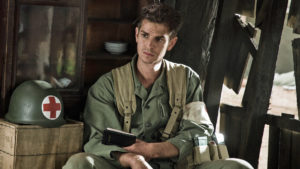
On April 1, 1942, Desmond Doss joined the United States Army at Camp Lee, Virginia but he refused to train with weapons because his personal beliefs as a Seventh-day Adventist and intention not to kill an enemy. He wanted to be an Army combat medic, but he was assigned to an infantry rifle company. While in training for combat Doos was under pressure from his colleges and superiors to take and train with the weapon but there are no records that he was been ever pulled out of the bed and beaten in the night as is seen in the movie.
Moreover, court scene never happened and it is a pure exaggeration. Desmon Doss received several threats with court-martial, but it never came to court. In the movie, his father Tom Doss has contacted his commanding officer who stops Desmond from being court-martialed. In real life, Tom Doss contacted the chairman of the church’s War Service Commission in Washington who made a call to the regimental commander asking if it was necessary for him to come investigate the situation with Desmond Doss. Probably, writing and reading letters is not so dramatic as last-second save in courtroom. That scene is not necessary and is simply obvious that this is a fabrication of filmmakers and not the actual history. Needless to say that Tom Dosses letter did not save him from court-martial because court on that matter never existed, but it helped Desmond Doss to get a 3-day pass to see his brother Harold before he returns to Navy. In the movie, he is denied to go on his own wedding; talking about Gibson making true drama.
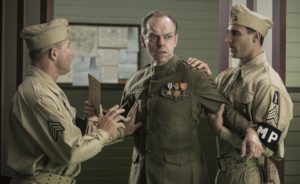
Wartime
If you have watched the movie you probably think that battle for Okinawa is first Doss battle. Not only that he served in 1944 in Guam and Philippines but also he was awarded a Bronze Star Medal for aiding wounded soldiers under fire. The battle for Okinawa and Maeda Escarpment (aka Hacksaw Ridge) took place in may 1945. While German troops in Europe were surrendering, Japanese troops were fiercely defending. Even Doos one time almost took grenade and tow to Japanese soldier so he could help his men.
Maeda Escarpment (ana Hacksaw Ridge) was huge cliff vital for taking Okinawa, an island from which the US could attack mainland of Japan. After Desmond’s company captured and secured the top of the cliff Japanese troops rushed in a counterattack. US troop retreated and left a large number of dead and wounded. Desmond Doss did not retreat but he remains all night (12 hours) helping wounded soldiers to get of Maeda Escarpment. However, the number of 75 soldiers he saved is not an accurate number. Doss had estimated the number of lives he saved to be 50, but his commanding officer wanted to credit him with saving 100 lives, so they compromised at 75. In the movie, Maeda Escarpment is exaggerated as seen on pictures.
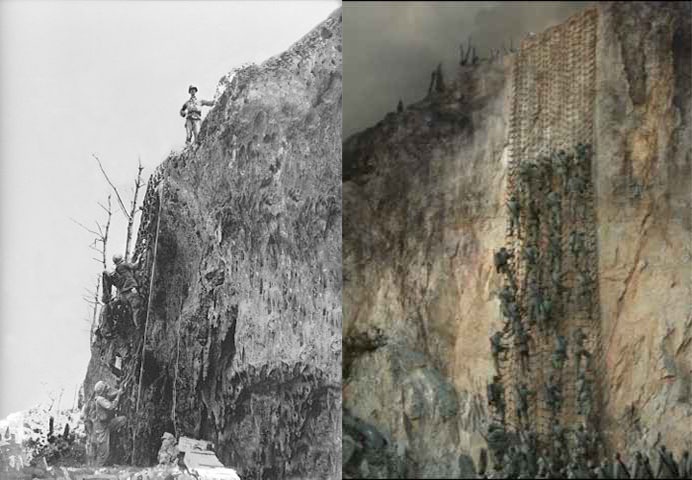
Gibson and company didn’t show Desmond’s wounding as it happened; Desmond got wounded by a grenade, but not as shown in the movie; playing football with grenades. More interesting is that he when he was lying and waiting, with 17 grenade shrapnels in him, he received a bullet in left arm from an enemy sniper. Bullet had shattered his left arm but Desmond decided to crawl all alone to a nearest aid station. It is unbelievable that Gibson did not use this for more dramatisation. His left it out the movie because he felt that audience will not believe in such a sequence of events but someone will believe in last second court Deus ex machina.
Postwar life in modesty
Soon after the War on November 1., 1945 Desmond received Medal of Honor from US President Harry S. Truman. Despite the award, his life was not easy; he got a modest pension, wounds left him with 90% disability, he spent five and half years in hospitals, he lost 5 ribs due to tuberculosis and for 12 years he was deaf until he received a cochlear implant in 1988. Despite the difficulties, he remains modest and lived on a small farm with wife, who become a nurse, and his son Desmond Jr. He remains consistent in modest life and didn’t sell rights on his personal story to no one despite the fact that money would make his life easier. He wanted his story to be told true or not told at all. His life is almost opposed to Audry Murphy, most decorated combat soldier of the World War II war (Among his 33 awards was the Medal of Honor), who become an actor and played himself in autobiography movie To Hell and and Back.
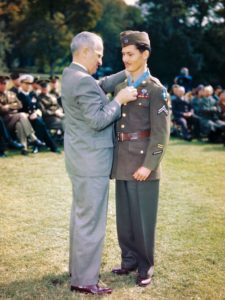
Conclusion – Drama and Religion
Hacksaw Ridge tell an incredible story about individual who wanted to help his country, but he did not want to kill anybody. A volunteer soldier that does not want to kill?! He was walking contradiction but he has become one of best inspiration story from World War II.
Such a story needed a good movie and Hacksaw Ridge did not deliver it. To be understood, Hacksaw Ridge is not a bad movie, it just isn’t that good. Every movie is a reflection of a current time in which is filmed and not the actual story time. Gibson sure likes stories about individual who fight bad system because he wants to help his community and country (Braveheart, etc.). In this movie, we have ideal Gibson’s hero; a fierce believer (Of course he is a Christian) who sacrifice himself for the greater good; this time is for America. Gibson wants to show us what is meant to be a good American.
The movie scenes are not bad; huge effort went to costumes, war scenes, scenography and hiding everything that could show that the movie is filmed in Australia. Nevertheless, this is a religious film with too much drama, and probably best for Desmond Doss that he never saw it.
Worst Sins:
- Fictional courtship
- Overdramatic trial that never happened
- Exaggerated height of Hacksaw Ridge


